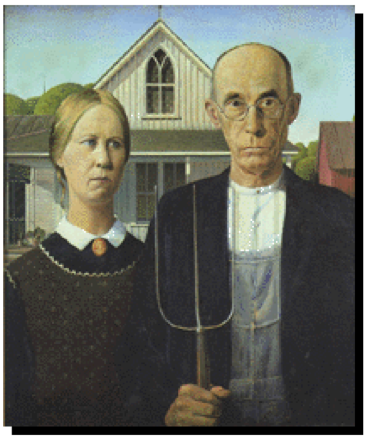
American Gothic
By Artist Grant Wood
American Gothic caused a stir in 1930 when it was exhibited for the first time at The Art Institute of Chicago and awarded a prize of 300 dollars. Newspapers across the country carried the story, and the painting of a farm couple posed before a white house brought Grant Wood instant fame. The Iowa native, then in his late 30s, was enchanted by a cottage he had seen in the small southern Iowa town of Eldon. Its Gothic Revival style, indicated by the upper window designed to resemble a medieval pointed arch, inspired the painting’s title. He asked his dentist and his sister Nan to pose as a farmer and his unmarried daughter.
This painting quickly became an icon for Middle America and is perhaps the best known portrait by the Iowan artist. Not surprisingly Americans took to Wood for he offered a national vision of hope during the Great Depression years. His vision of the American heartland seemed to touch a troubled country deeply; his paintings offered a land that responded to cultivation lusciously rather than blowing away in the tornados of the dustbowl, as well as farmers and their families who offered a bounty with round and blushing cheeks.
Although largely a self-trained artist, Wood spent significant amounts of time painting in Europe. He is widely quoted as denouncing his European training and remarking that "all the really good ideas I'd ever had came to me while I was milking a cow. So I went back to Iowa."
Wood dedicated the last six years of his life (dying in 1942 at the age of 50) to instilling the values of regionalism in the University of Iowa art program against strong resistance. Regionalism, to Grant Wood, was a simple concept: artists should paint what is around them, what they know and what they see. He took great inspiration from the Flemish masters, noting their skill in painting local scenes while capturing the universal significance of the subject matter. Wood was for the most part neutral on the finer points of style or form; he encouraged his students and fellow artists to experiment broadly, insisting that those in his art classes paint on brown wrapping paper so that they felt freer to test new stylistic waters.
Although Wood's landscapes were received as idealized visions of America's heartland, a critical feature of the paintings is that they are pointedly not contemporary. America in the 1930's was in the grips of the machine age, erecting skyscrapers and building technological marvels like the Hoover Dam--yet machines do not enter into Wood's landscapes. Wood's landscapes are not about America in the 1930's. Rather, they reflect an America of the 1880's or before; on one level, they are nostalgia for a constructed American past. The fact that they were painted during the Great Depression underscores more fully what appears to be Wood's total refusal to acknowledge the national situation at hand. Surely these geometric and carefully constructed landscapes werenotwhat Wood saw around him; more likely, they were what he wanted to see.
